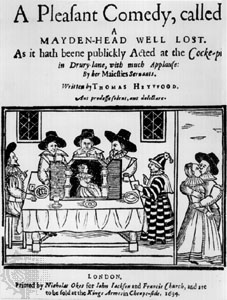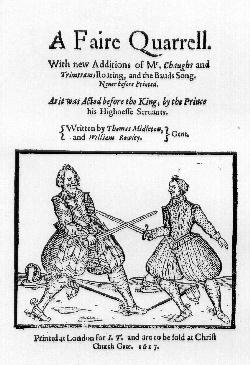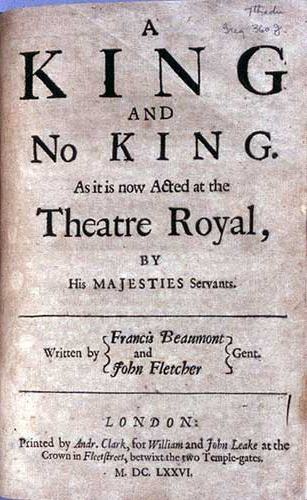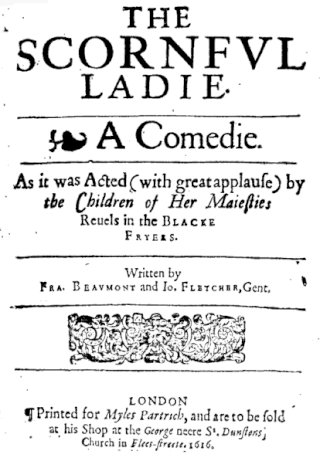Related Research Articles
This article presents lists of the literary events and publications in 1661.
William Rowley was an English Jacobean dramatist, best known for works written in collaboration with more successful writers. His date of birth is estimated to have been c. 1585; he was buried on 11 February 1626 in the graveyard of St James's, Clerkenwell in north London.

Thomas Heywood was an English playwright, actor, and author. His main contributions were to late Elizabethan and early Jacobean theatre. He is best known for his masterpiece A Woman Killed with Kindness, a domestic tragedy, which was first performed in 1603 at the Rose Theatre by the Worcester's Men company. He was a prolific writer, claiming to have had "an entire hand or at least a maine finger in two hundred and twenty plays", although only a fraction of his work has survived.

The Shakespeare apocrypha is a group of plays and poems that have sometimes been attributed to William Shakespeare, but whose attribution is questionable for various reasons. The issue is separate from the debate on Shakespearean authorship, which addresses the authorship of the works traditionally attributed to Shakespeare.
The Birth of Merlin, or, The Child Hath Found his Father is a Jacobean play, probably written in whole or part by William Rowley. It was first performed in 1622 at the Curtain Theatre in Shoreditch. It contains a comic depiction of the birth of the fully grown Merlin to a country girl, and also features figures from Arthurian legend, including Uther Pendragon, Vortigern, and Aurelius Ambrosius.

Locrine is an Elizabethan play depicting the legendary Trojan founders of the nation of England and of Troynovant (London). The play presents a cluster of complex and unresolved problems for scholars of English Renaissance theatre.

Francis Kirkman appears in many roles in the English literary world of the second half of the seventeenth century, as a publisher, bookseller, librarian, author and bibliographer. In each he is an enthusiast for popular literature and a popularising businessman, described by one modern editor as "hovering on the borderline of roguery".

The Merry Devil of Edmonton is an Elizabethan-era stage play; a comedy about a magician, Peter Fabell, nicknamed the Merry Devil. It was at one point attributed to William Shakespeare, but is now considered part of the Shakespeare Apocrypha.
The Old Law, or A New Way to Please You is a seventeenth-century tragicomedy written by Thomas Middleton, William Rowley, and Philip Massinger. It was first published in 1656, but is generally thought to have been written about four decades earlier.
Fair Em, the Miller's Daughter of Manchester, is an Elizabethan-era stage play, a comedy written c. 1590. It was bound together with Mucedorus and The Merry Devil of Edmonton in a volume labelled "Shakespeare. Vol. I" in the library of Charles II. Though scholarly opinion generally does not accept the attribution to William Shakespeare, there are a few who believe they see Shakespeare's hand in this play.

Blurt, Master Constable, or the Spaniards' Night Walk is a late Elizabethan comedy, printed anonymously in 1602 and usually attributed to either Thomas Middleton or Thomas Dekker.

A Fair Quarrel is a Jacobean tragicomedy, a collaboration between Thomas Middleton and William Rowley that was first published in 1617.
A Cure for a Cuckold is a late Jacobean era stage play. It is a comedy written by John Webster and William Rowley. The play was first published in 1661, though it is understood to have been composed some four decades earlier.

The Maid in the Mill is a late Jacobean era stage play, a comedy written by John Fletcher and William Rowley. It was initially published in the first Beaumont and Fletcher folio of 1647.

A King and No King is a Jacobean era stage play, a tragicomedy written by Francis Beaumont and John Fletcher and first published in 1619. It has traditionally been among the most highly praised and popular works in the canon of Fletcher and his collaborators.

The Scornful Lady is a Jacobean era stage play, a comedy written by Francis Beaumont and John Fletcher, and first published in 1616, the year of Beaumont's death. It was one of the pair's most popular, often revived, and frequently reprinted works.
John of Bordeaux, or The Second Part of Friar Bacon, is an Elizabethan era stage play, the anonymous sequel to Robert Greene's Friar Bacon and Friar Bungay. The play was never printed in its own historical era and survived in a single, untitled, defective manuscript until it was named and published in 1936. It is usually dated to the 1590–94 period, shortly after the success of Greene's original Friar Bacon.
A Looking Glass for London and England is an Elizabethan era stage play, a collaboration between Thomas Lodge and Robert Greene. Recounting the Biblical story of Jonah and the fall of Nineveh, the play is a noteworthy example of the survival of the Medieval morality play style of drama in the period of English Renaissance theatre.
A New Wonder, a Woman Never Vexed is a Jacobean era stage play, often classified as a city comedy. Its authorship was traditionally attributed to William Rowley, though modern scholarship has questioned Rowley's sole authorship; Thomas Heywood and George Wilkins have been proposed as possible contributors.
The Travels of the Three English Brothers is an early Jacobean era stage play, an adventure drama written in 1607 by John Day, William Rowley, and George Wilkins. The drama was based on the true-life experiences of the three Shirley brothers, Sir Anthony Shirley, Sir Thomas Shirley, and Robert Shirley. The play illustrates the trend toward extreme topicality in some works of English Renaissance drama.
References
- Adams, Joseph Quincy. "Greene's Menaphon and The Thracian Wonder." Modern Philology Vol. 3 No. 3 (January 1906), pp. 317–25.
- Brereton, J. le Gay. "The Relation of The Thracian Wonder to Greene's Menaphon." Modern Language Review Vol. 2 No. 1 (October 1906), pp. 34–8.
- Hatcher, O. L. "The Sources and Authorship of The Thracian Wonder." Modern Language Notes Vol. 23 No. 1 (January 1908), pp. 16–20.
- Logan, Terence P., and Denzell S. Smith, eds. The Popular School: A Survey and Bibliography of Recent Studies in English Renaissance Drama. Lincoln, NE, University of Nebraska Press, 1975.
- Nolan, Michael, ed. "The Thracian Wonder" by William Rowley and Thomas Heywood: A Critical Edition. Salzburg, University of Salzburg/Portland, OR, International Specialized Book Services, 1997.